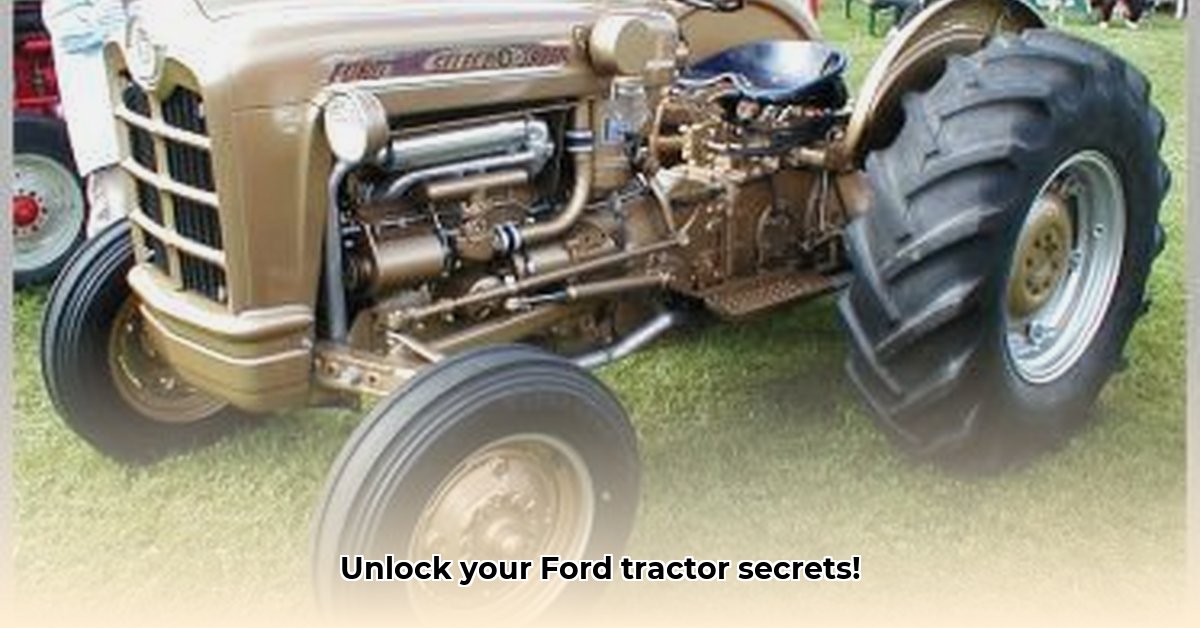
Unearthing the secrets hidden within your Ford tractor's serial number can be like solving a historical puzzle. This comprehensive guide will equip you with the knowledge and tools to decode this unique identifier and unlock valuable information about your machine. For more information on Ford 5000 tractor weight, see this helpful resource: Ford 5000 Tractor Weight. Let's begin!
Locating the Serial Number: The First Clue
Before decoding, you must find the serial number. Its location varies depending on the model year and specific model. For older models (9N, 2N, 8N), it's often hand-stamped on the engine block. Later models may have it on the transmission housing or a dedicated identification plate. High-resolution photos are crucial for accurate recording. A simple online search for "[Your Ford Tractor Model] serial number location" will often yield helpful images.
Deciphering the Code: Unraveling Your Tractor's Identity
Each character in the serial number—letter and number—reveals aspects of your tractor's history, including manufacturing location and approximate build date. However, the system wasn't consistent throughout Ford's production history, adding complexity. Let's break down typical components:
- Prefix: Usually a letter/number combination indicating the main model series (e.g., "8N" series).
- Model Code: A blend of numbers and letters providing details about the engine, transmission, and optional features.
- Numerical Sequence: A unique number representing the tractor's production sequence, providing an estimate of the production date.
Beyond these, additional codes may reveal manufacturing location (e.g., indicating US or Basildon, England production). Remember, early systems differ significantly from later ones. Careful observation is key. Have you ever noticed how small details can sometimes unlock the greatest secrets?
Cross-Referencing for Model Identification: Putting the Pieces Together
Once you've deciphered the components, identify your tractor's precise model using online resources. Dedicated Ford tractor websites and forums offer databases matching serial numbers to models and providing build dates and factory origins. These websites are invaluable resources for enthusiasts, providing a wealth of knowledge on various Ford tractor models. Several online communities also provide additional insights and assistance. The power of community support can help you overcome even the toughest challenges!
Practical Applications: Why This Matters
Understanding your Ford tractor's serial number offers significant practical benefits. It's crucial for:
- Parts Sourcing: Ensuring you get the correct replacement parts, preventing costly mistakes.
- Restoration: Providing a roadmap to its original configuration.
- Authenticity Verification: Establishing the tractor's genuineness and potential value.
- Historical Research: Contributing to the understanding of Ford tractor history.
Advanced Decoding: Tackling the Tough Cases
Some model years and variations produced inconsistencies. For these, you might need additional research, contacting experienced owners, or consulting archival materials like old brochures and manuals. Remember, even the most experienced restorers occasionally encounter unforeseen challenges. The persistence of the enthusiast often leads to the greatest discoveries. Dedicated Ford tractor forums can also provide expert assistance with those tricky serial numbers.
Resources and Further Exploration
This guide provides a foundation, but your journey continues! Numerous online resources can expand your knowledge and assist in decoding. Ford tractor websites and forums are invaluable for accessing serial number databases and expert advice. Remember cross-referencing information from multiple sources for accuracy. The pursuit of knowledge is a rewarding journey.
How to Decode Regional Production Codes on Pre-1960s Ford Tractor Serial Numbers
Pre-1960s Ford tractor serial numbers offer clues about manufacturing location and date, but accuracy varies. Early models primarily used engine block numbers (less precise); later models used transmission housings (more direct assembly date information). Decoding requires careful examination of prefixes, model codes, and numerical sequences. Understanding these codes assists parts sourcing, restoration, and historical research. Did you know that even seemingly insignificant markings can reveal surprising information about your tractor's origins?
Step-by-Step Guide:
- Identify the Prefix: Initial letters/numbers indicating the model (e.g., "9N," "2N," "8N").
- Analyze the Model Code: Often indicates engine size or variations.
- Examine the Numerical Sequence: Represents the sequential production number; be aware of variations (e.g., lowercase "b" for "6").
- Look for Additional Codes: Might be stamped elsewhere, hinting at production facility or date.
- Cross-Reference: Use online resources (like the one listed below) and Ford tractor manuals.
Interpreting Regional Production Codes: Unfortunately, there's no single, universal code chart for pre-1960s Ford tractors. Combining detailed research and educated guesswork is frequently necessary. The more data points (casting dates, location codes) you can find, the better.
Practical Applications: Knowing your tractor's serial number is vital for verifying authenticity, sourcing parts accurately, assisting restoration efforts, and contributing to historical research.
MyFordTractors.com: Serial Number Decoder